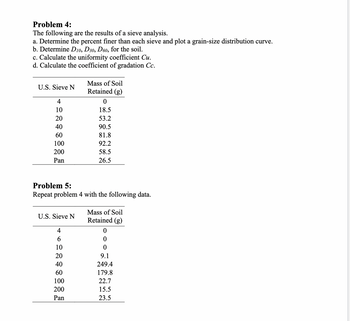
Structural Analysis
6th Edition
ISBN: 9781337630931
Author: KASSIMALI, Aslam.
Publisher: Cengage,
expand_more
expand_more
format_list_bulleted
Concept explainers
Question

Transcribed Image Text:Problem 4:
The following are the results of a sieve analysis.
a. Determine the percent finer than each sieve and plot a grain-size distribution curve.
b. Determine D10, D30, D60, for the soil.
c. Calculate the uniformity coefficient Cu.
d. Calculate the coefficient of gradation Cc.
U.S. Sieve N
4
10
20
40
60
100
200
Pan
U.S. Sieve N
Mass of Soil
Retained (g)
Problem 5:
Repeat problem 4 with the following data.
4
6
10
20
40
60
100
200
Pan
0
18.5
53.2
90.5
81.8
92.2
58.5
26.5
Mass of Soil
Retained (g)
0
0
0
9.1
249.4
179.8
22.7
15.5
23.5
Expert Solution
This question has been solved!
Explore an expertly crafted, step-by-step solution for a thorough understanding of key concepts.
Step by stepSolved in 5 steps with 7 images

Knowledge Booster
Learn more about
Need a deep-dive on the concept behind this application? Look no further. Learn more about this topic, civil-engineering and related others by exploring similar questions and additional content below.Similar questions
- EXERCICE 4 Sieve analysis was performed from which the results were summarized in the following table. 1 a) Plot the grain size curve b) Calculate the coefficient of uniformity and the coefficient of gradation. c) Give a first idea about the classification of such soil. U.S. Sieve Opening (mm) Mass retained in each sieve (gr) 1 20 4 4.750 10 2.000 40 20 0.850 60 40 0.425 89 60 0.250 140 80 0.180 122 100 0.150 210 200 0.075 56 Pan 12arrow_forward2.3 The following are the results of a sieve analysis: Mass of soil retained (g) U.S. sieve no. 4 10 20 40 60 100 200 Pan 28 42 48 128 221 86 40 24 ⒸCengage Leaming 2014 a. Determine the percent finer than each sieve and plot a grain-size distribution curve. b. Determine D10, D30, and D60 from the grain-size distribution curve. c. Calculate the uniformity coefficient, C₁- d. Calculate the coefficient of gradation, C.arrow_forwardSomeone can help me with this one. Pleasearrow_forward
- Note: Give me both solutions with clear steps. A) The particle size distribution for Soil 1 is shown. What are the USCS group symbol and group name of this soil? B) The particle size distribution for Soil 2 is shown. The soil is inorganic and has the following Atterberg Limit values: LL=34 and PL=29. What are the USCS group symbol and group name for this soil?arrow_forwardSG is 2.66 and temperature is 18 degrees celciusarrow_forward2.8 2.7 The following are the results of a sieve and hydrometer analysis. Sieve number/ grain size Analysis Sieve Hydrometer Analysis Sieve 40 80 170 200 0.04 mm 0.02 mm 0.01 mm 0.005 mm 0.0015 mm Hydrometer Sieve number/ grain size Percent finer than a. Draw the grain-size distribution curve. b. Determine the percentages of gravel, sand, silt, and clay according to the MIT system. c. Repeat Part b according to the USDA system. d. Repeat Part b according to the AASHTO system. Repeat Problem 2.7 with the following data: 20 30 40 60 80 200 0.05 mm 0.03 mm 0.015 mm 0.006 mm 0.004 mm 0.0015 mm 100 96 85 80 59 39 26 15 8 Cengage Learning 2014 Percent finer than 100 96 90 76 65 34 27 19 11 7 6 5 Ⓒ Cengage Learning 2014arrow_forward
arrow_back_ios
arrow_forward_ios
Recommended textbooks for you

 Structural Analysis (10th Edition)Civil EngineeringISBN:9780134610672Author:Russell C. HibbelerPublisher:PEARSON
Structural Analysis (10th Edition)Civil EngineeringISBN:9780134610672Author:Russell C. HibbelerPublisher:PEARSON Principles of Foundation Engineering (MindTap Cou...Civil EngineeringISBN:9781337705028Author:Braja M. Das, Nagaratnam SivakuganPublisher:Cengage Learning
Principles of Foundation Engineering (MindTap Cou...Civil EngineeringISBN:9781337705028Author:Braja M. Das, Nagaratnam SivakuganPublisher:Cengage Learning Fundamentals of Structural AnalysisCivil EngineeringISBN:9780073398006Author:Kenneth M. Leet Emeritus, Chia-Ming Uang, Joel LanningPublisher:McGraw-Hill Education
Fundamentals of Structural AnalysisCivil EngineeringISBN:9780073398006Author:Kenneth M. Leet Emeritus, Chia-Ming Uang, Joel LanningPublisher:McGraw-Hill Education
 Traffic and Highway EngineeringCivil EngineeringISBN:9781305156241Author:Garber, Nicholas J.Publisher:Cengage Learning
Traffic and Highway EngineeringCivil EngineeringISBN:9781305156241Author:Garber, Nicholas J.Publisher:Cengage Learning


Structural Analysis (10th Edition)
Civil Engineering
ISBN:9780134610672
Author:Russell C. Hibbeler
Publisher:PEARSON

Principles of Foundation Engineering (MindTap Cou...
Civil Engineering
ISBN:9781337705028
Author:Braja M. Das, Nagaratnam Sivakugan
Publisher:Cengage Learning

Fundamentals of Structural Analysis
Civil Engineering
ISBN:9780073398006
Author:Kenneth M. Leet Emeritus, Chia-Ming Uang, Joel Lanning
Publisher:McGraw-Hill Education


Traffic and Highway Engineering
Civil Engineering
ISBN:9781305156241
Author:Garber, Nicholas J.
Publisher:Cengage Learning